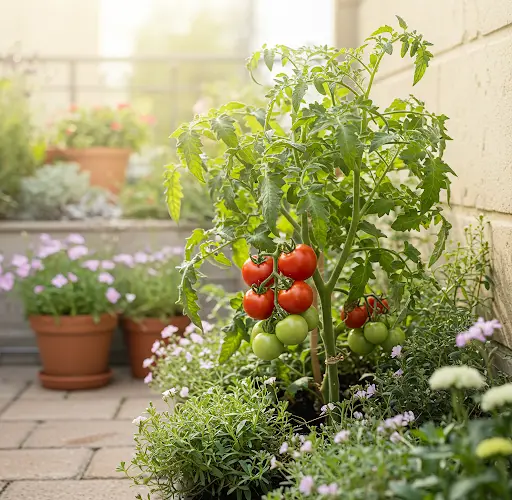BushSteak tomatoes are a compact, high-yielding variety ideal for small gardens, patios, and container gardening. These determinate plants produce large, flavorful fruits without sprawling vines, making them perfect for limited spaces. This guide will walk you through growing BushSteak tomatoes from seed to harvest, ensuring a bountiful crop even in confined areas.
1. Starting Seeds Indoors
Begin by sowing BushSteak tomato seeds indoors 6–8 weeks before your area’s last expected frost date. Use a quality seed-starting mix and plant seeds about ¼ inch deep in seed trays or small pots. Maintain a consistent soil temperature of 80–85°F (27–29°C) to encourage germination, which typically occurs within 7–14 days.
Keep the soil moist but not waterlogged by misting it regularly. Once seedlings emerge, place them in a location with plenty of light, such as a sunny windowsill or under grow lights, to prevent leggy growth.
2. Hardening Off Seedlings
Before transplanting seedlings outdoors, they need to be acclimated to outdoor conditions through a process called hardening off. Start this process about two weeks before transplanting by placing the seedlings outdoors in a sheltered spot for a few hours each day, gradually increasing their exposure to sunlight and outdoor temperatures. This helps reduce transplant shock and prepares the plants for their new environment.
3. Transplanting into Containers or Garden Beds
Once the danger of frost has passed and nighttime temperatures consistently stay above 55°F (13°C), transplant your hardened-off seedlings into their final growing location. For container gardening, choose pots that are at least 20 inches deep and 24 inches wide to accommodate the plant’s root system.
Use a well-draining, fertile potting mix rich in organic matter. When planting, bury the seedlings deeply, covering the stem up to the first set of true leaves. This encourages a strong root system, providing better support and nutrient uptake for the plant.
4. Providing Support
Although BushSteak tomatoes are determinate and more compact, their large fruits can weigh down branches. Provide support using stakes or tomato cages to keep the plants upright and prevent branches from breaking. Install supports at planting time to avoid disturbing the roots later on.
5. Watering and Fertilizing
Consistent watering is crucial for healthy tomato plants. Water deeply and regularly, keeping the soil evenly moist but not soggy. Inconsistent watering can lead to issues like blossom end rot.
Fertilize your plants with a balanced, slow-release fertilizer or compost. Avoid high-nitrogen fertilizers, as they can promote excessive foliage growth at the expense of fruit production. Instead, choose fertilizers formulated for tomatoes or vegetables to support flowering and fruiting.
6. Pruning and Maintenance
While determinate varieties like BushSteak require less pruning than indeterminate types, removing any suckers (small shoots that develop between the main stem and branches) can improve air circulation and reduce disease risk. Additionally, remove any yellowing or diseased leaves to maintain plant health.
7. Pest and Disease Management
Monitor your plants regularly for common tomato pests such as aphids, whiteflies, and hornworms. Use organic pest control methods like neem oil or insecticidal soap if infestations occur. To prevent diseases like blight, ensure proper spacing between plants for good air circulation, avoid overhead watering, and remove any infected foliage promptly.
8. Harvesting
BushSteak tomatoes typically mature in about 65–75 days after transplanting. Harvest fruits when they are fully colored and slightly firm to the touch. Regular harvesting encourages the plant to produce more fruit. Use a sharp knife or scissors to cut the tomatoes from the vine to avoid damaging the plant.
9. Final Tips for Success
-
Sunlight: Ensure your tomato plants receive at least 6–8 hours of direct sunlight daily.
-
Mulching: Apply mulch around the base of the plants to retain soil moisture and suppress weeds.
-
Rotation: If planting in garden beds, rotate tomato crops each year to prevent soil-borne diseases.
-
Companion Planting: Consider planting basil, marigolds, or nasturtiums nearby to deter pests and enhance growth.
By following these steps, you can enjoy a plentiful harvest of BushSteak tomatoes, even in small garden spaces or patios. With proper care and attention, these compact plants will reward you with delicious, homegrown tomatoes throughout the growing season.



